A faulty engine can be very frustrating and expensive. Spark plug fouling is a common problem. It can make your engine run poorly, use more fuel, and even get damaged.
It’s important to know the signs of spark plug fouling early. This way, you can fix the problem before it gets worse. Knowing the causes and signs helps you keep your engine in good shape and avoid big repair costs.
Look out for signs like a rough engine, less power, and bad fuel efficiency. These can mean your spark plugs are fouled. In this article, we’ll talk about the common causes and signs of spark plug fouling. This will help you take care of your engine better.
Topic Summary
- What Is Spark Plug Fouling and Why It Matters
- Symptoms of Spark Plug Fouling
- Types of Spark Plug Fouling and Their Visual Indicators
- Primary Causes of Spark Plug Fouling
- Case Studies: Real-World Spark Plug Fouling Scenarios
- Diagnosing Spark Plug Fouling
- Preventing Spark Plug Fouling
- Conclusion
- FAQs on Identifying Spark Plug Fouling: Common Signs and Causes
- What Are The Common Signs of Spark Plug Fouling?
- How Can I Diagnose Spark Plug Fouling?
- What Causes Spark Plug Fouling?
- How Can I Prevent Spark Plug Fouling?
- Can Spark Plug Fouling Be Resolved Without Professional Help?
- What Are The Symptoms of a Fouled Spark Plug?
- How Do I Know if My Spark Plugs Are Fouled?
- What Are The Warning Signs of Spark Plug Fouling?
- How often Should I Check My Spark Plugs For Fouling?
Key Takeaways
- Recognizing common signs of spark plug fouling
- Understanding the causes of spark plug fouling
- Importance of maintaining engine health
- Proactive steps to prevent engine damage
- Common indicators of spark plug fouling
What Is Spark Plug Fouling and Why It Matters
Knowing about spark plug fouling is key to keeping your engine running well. Spark plugs are vital for starting the engine’s fire. They light the fuel-air mix that makes the engine go.
The Function of Spark Plugs in Engine Operation
Spark plugs create the spark that starts the fuel-air mix in the engine. They must work right for the engine to run well. This is important for good fuel use and less pollution.
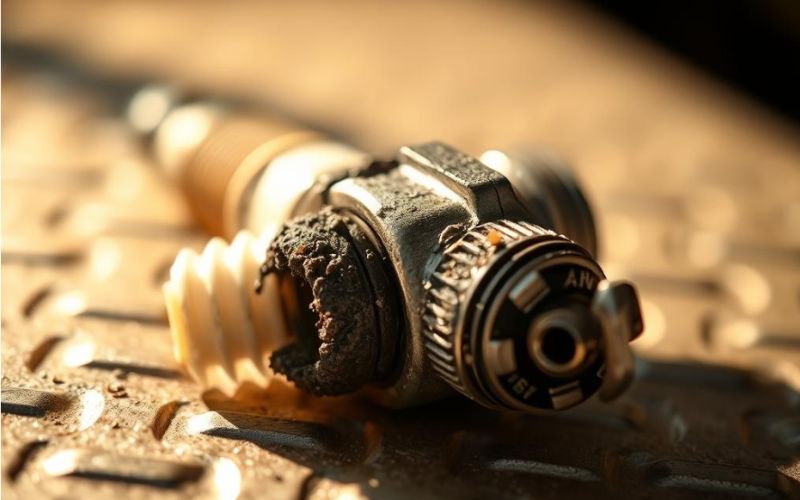
How Fouling Affects Engine Performance
Fouled spark plugs can’t make a strong spark. This means the engine might misfire, use more fuel, and lose power. Spotting signs like rough idling or hard starts is important. It helps fix the problem before it gets worse.
Car experts say, “Regular checks and replacing spark plugs stop fouling. This keeps your engine running at its best.”
Symptoms of Spark Plug Fouling
It’s important to know the signs of spark plug fouling to keep your engine running well. Spark plug fouling can cause many problems, like less engine power and even engine failure. Spotting these signs early can help fix issues before they get worse.
Engine Misfires and Rough Idling
Engine misfires and rough idling are common signs of fouled spark plugs. When spark plugs don’t work right, they can’t light the fuel-air mix. This makes the engine run unevenly, worse when it’s idling.
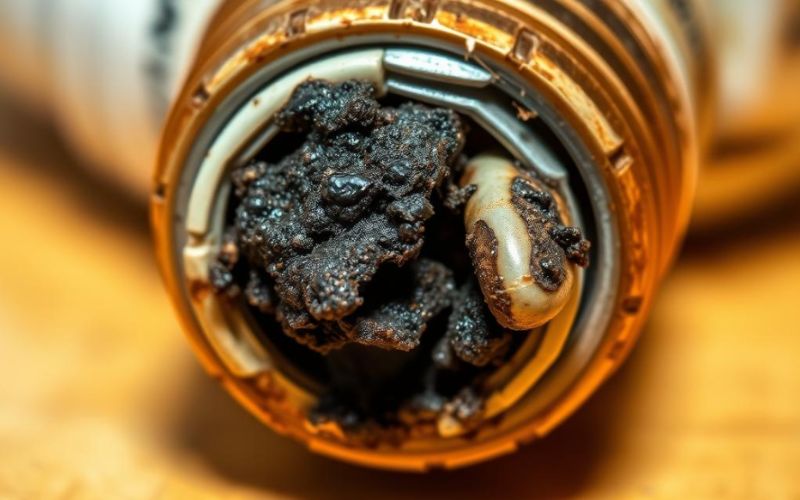
Decreased Fuel Economy
Fouled spark plugs also mean your car uses more fuel. This is because the engine works harder, burning more gas. It’s a sign of trouble and can cost you more money.
Hard Starting Conditions
Spark plug fouling makes starting your car harder, too. In cold weather, it’s even tougher. This is because fouled spark plugs can’t spark well enough to start the engine.
Loss of Engine Power and Acceleration
Lastly, fouled spark plugs can make your car feel slow and weak. As spark plugs wear out, the engine can’t power up as well. This makes your car less responsive and slower.
Types of Spark Plug Fouling and Their Visual Indicators
Spark plug fouling can happen in many ways. Each has its own signs that help find the problem. Knowing these types is key to fixing the issue.
Carbon Fouling (Black, Dry Soot)
Carbon fouling shows as black, dry soot on the spark plug. It’s usually from too much fuel, idling too long, or a dirty air filter. This soot stops the spark plug from working right.
Oil Fouling (Wet, Greasy Deposits)
Oil fouling means oil gets into the engine, making spark plugs wet and greasy. It’s often from worn parts like piston rings or valve stem seals. This can cause the engine to misfire and run poorly.
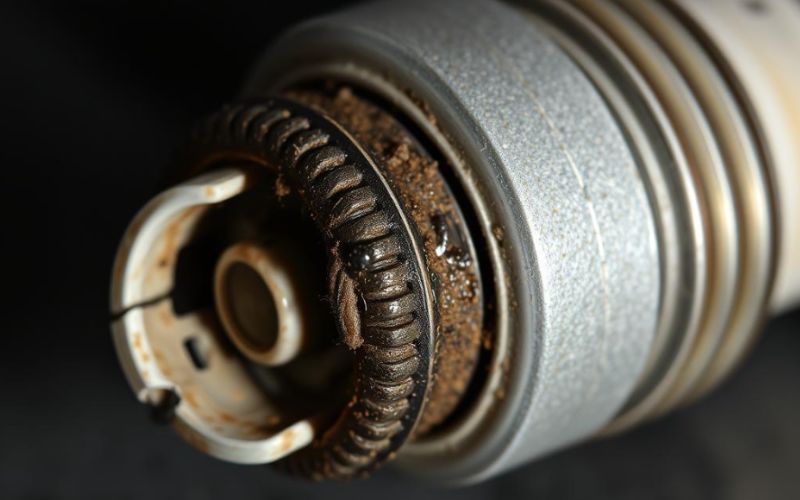
Fuel Fouling (Black, Wet Deposits)
Fuel fouling shows as black, wet spots on the spark plug. It’s from too much fuel. This can make the engine run badly, idle rough, and use more fuel.
Ash Deposits and Thermal Fouling
Ash deposits come from burning engine oil or fuel additives, leaving hard, abrasive stuff. Thermal fouling happens when the spark plug gets too hot, often from pre-ignition or detonation. Both hurt the engine’s performance a lot.
Knowing what kind of fouling you have is important to fix it right. Regular checks and upkeep can stop fouling and keep the engine running well.
- Carbon fouling: Black, dry soot deposits
- Oil fouling: Wet, greasy deposits
- Fuel fouling: Black, wet deposits
- Ash deposits and thermal fouling: Hard, abrasive residue or overheated spark plugs
Primary Causes of Spark Plug Fouling
Many things can make spark plugs foul. These include problems with fuel, oil, and the ignition system. Knowing what causes it helps fix and prevent fouling.
Rich Fuel Mixture Issues
A rich fuel mix means too much fuel and not enough air. This leads to incomplete burning, causing carbon to stick to spark plugs. Autoboot says, “A fouled spark plug can mean a bigger issue, like a bad fuel injector or a clogged air filter.”
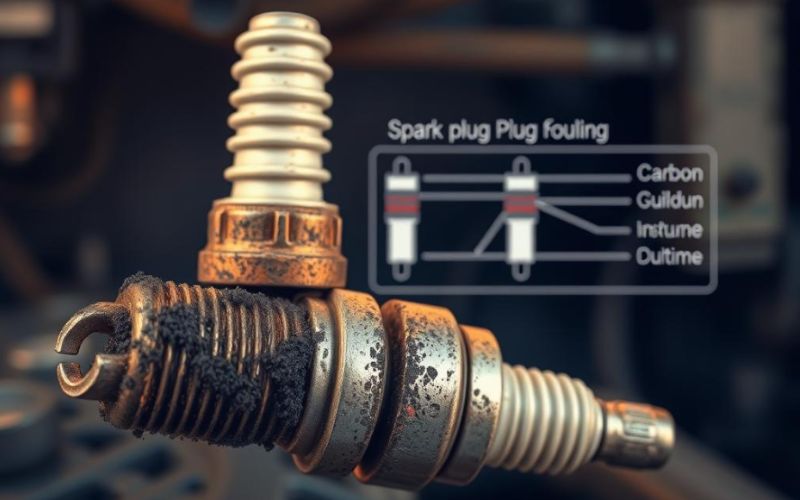
Oil Consumption Problems
Oil leaks into the engine can foul spark plugs. This lowers engine performance. Checking oil levels and fixing leaks helps avoid this.
Ignition System Failures
Problems with the ignition system, like bad spark plug wires or a faulty coil, can foul spark plugs. This happens when the system doesn’t work right, causing incomplete burning. An ASE Certified Mechanic says, “The ignition system is key to the engine’s work. Any failure can cause many problems, including fouling.”
— ASE Certified Mechanic
Impact of Short-Trip Driving
Driving short distances without letting the engine warm up can foul spark plugs. This kind of driving causes incomplete burning and deposits on plugs.
Knowing the main causes of spark plug fouling helps car owners prevent and fix it. This keeps the engine running well and lasting longer.
Case Studies: Real-World Spark Plug Fouling Scenarios
Understanding spark plug fouling is key to fixing car problems. It can hurt your car’s performance if not fixed fast. Real cases show us what causes it, how to spot it, and how to fix it.
Carbon Fouling in a Toyota Camry
A 2015 Toyota Camry had trouble idling smoothly and used more fuel. The spark plugs were covered in black soot, showing carbon fouling.
Symptoms Reported
- Rough idling
- Decreased fuel economy
- Occasional engine misfires
Diagnostic Findings
The spark plugs had a lot of carbon buildup. This meant the fuel mix was too rich.
Resolution Methods
Changing the spark plugs and adjusting the fuel mix fixed the problem. The car ran better and used less fuel.
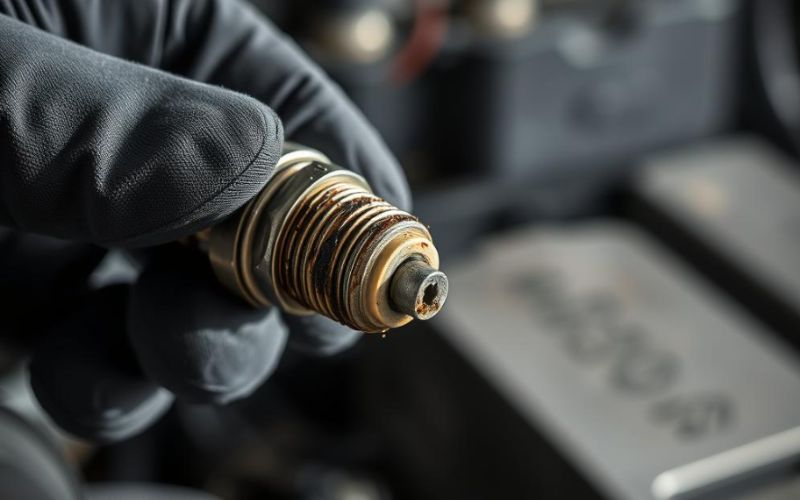
Oil Fouling in a Ford F-150
A 2018 Ford F-150 had trouble starting and misfired. Tests showed oil on the spark plugs, making them wet and greasy.
Symptoms Reported
- Hard starting
- Engine misfires
- Noticeable decrease in engine power
Diagnostic Findings
Spark plugs showed oil fouling. This meant oil was leaking into the engine.
Resolution Methods
Changing the spark plugs and fixing the oil leak fixed the problem. The car ran better.
Fuel Fouling in a Chevrolet Silverado
A 2012 Chevrolet Silverado had poor engine performance and slow acceleration. The spark plugs were covered in black, wet fuel deposits.
Symptoms Reported
- Poor engine performance
- Decreased acceleration
- Fuel odor
Diagnostic Findings
The spark plugs were fuel fouled. This suggested a problem with the fuel system, like a bad fuel injector.
Resolution Methods
Changing the spark plugs and cleaning the fuel system helped. Replacing a faulty fuel injector fixed the problem. The car ran well again.
Diagnosing Spark Plug Fouling
Learning how to spot spark plug fouling can save you money and time. It helps avoid costly repairs. To do this, you need the right tools and a careful inspection.
Essential Diagnostic Tools
You’ll need a few tools to check for spark plug fouling. These include a spark plug socket, a ratchet, and a spark tester. A spark plug analyzer is also helpful for checking the spark plugs’ health.
“A spark plug analyzer is a valuable tool for diagnosing spark plug fouling as it provides detailed information about the spark plug’s condition,” says a leading automotive expert.
Step-by-Step Inspection Process
The inspection process has several steps:
- Remove the spark plug wire and spark plug.
- Inspect the spark plug for signs of fouling.
- Use a spark tester to check for spark.
- Analyze the spark plug condition using a spark plug analyzer.
Reading Spark Plug Conditions
It’s important to understand what spark plug conditions mean. A fouled spark plug can look wet, dry, or oily. For example, carbon fouling is black and dry, while oil fouling is wet and greasy.
When to Seek Professional Help
If you’re not sure about spark plug fouling or if the problem doesn’t go away, get help. A mechanic can give a detailed diagnosis and suggest repairs.
By following these steps and using the right tools, you can find and fix spark plug fouling. This keeps your engine running well.
Preventing Spark Plug Fouling
To avoid spark plug fouling, knowing how to prevent it is important. By following a few simple steps, car owners can lower the risk of fouling. This keeps their engine running well.
Recommended Maintenance Schedules
Regular car care is key to avoiding spark plug fouling. Following the recommended schedule for spark plug replacement helps a lot. A study found that regular spark plug replacement can boost engine performance by up to 30%.
“Regular spark plug replacement can improve engine performance by up to 30%.”
Engine Maintenance Study
Selecting Appropriate Spark Plugs for Your Vehicle
Choosing the right spark plugs is very important. Each car needs a specific type of spark plug to avoid fouling. Check your car’s manual or talk to a pro to find the best spark plugs for you.
Driving Habits That Reduce Fouling Risk
Good driving habits can also help prevent fouling. Try to avoid short trips, as they can cause fouling. Also, drive at moderate speeds and avoid extreme temperatures.
Fuel and Oil Quality Considerations
Using top-notch fuel and oil is also important. Bad fuel can leave deposits on spark plugs, while low-quality oil can cause fouling. Make sure to use the right fuel and oil for your car.
Conclusion
It’s important to know the signs of spark plug fouling to keep your engine running well. Spark plug fouling can show up in many ways. This includes engine misfires, rough idling, lower fuel economy, and hard starts.
To diagnose spark plug fouling, look for signs like carbon, oil, or fuel on the plugs. Also, understand why it happens. This could be due to a rich fuel mix, oil leaks, or ignition system issues.
Knowing the symptoms and acting early can help avoid fouling. This keeps your spark plugs working right and your car in good shape.
Regular car care is key. This includes following maintenance schedules, choosing the right spark plugs, and driving smart. These steps can really cut down on fouling problems.
FAQs on Identifying Spark Plug Fouling: Common Signs and Causes
What Are The Common Signs of Spark Plug Fouling?
Signs include engine misfires and rough idling. You might also see a drop in fuel economy. Hard starts and less power are other signs.
How Can I Diagnose Spark Plug Fouling?
Look for signs like carbon or oil on spark plugs. Use tools to check engine performance too.
What Causes Spark Plug Fouling?
It’s often due to too much fuel or oil leaks. Ignition problems and short trips can also cause it.
How Can I Prevent Spark Plug Fouling?
Follow maintenance schedules and choose the right spark plugs. Drive smart and use quality fuel and oil.
Can Spark Plug Fouling Be Resolved Without Professional Help?
Cleaning or replacing spark plugs might fix it. But, if it’s complex, you might need a pro.
What Are The Symptoms of a Fouled Spark Plug?
Look out for engine misfires and rough idling. Fuel economy drops, and starting gets harder. Engine performance also suffers.
How Do I Know if My Spark Plugs Are Fouled?
Check for black soot (carbon fouling) or greasy deposits (oil fouling). Look for black, wet fuel fouling too.
What Are The Warning Signs of Spark Plug Fouling?
Watch for decreased engine performance and rough running. Trouble starting is another warning.
How often Should I Check My Spark Plugs For Fouling?
Check them during routine maintenance. This is usually every 30,000 to 100,000 miles, based on your vehicle.

